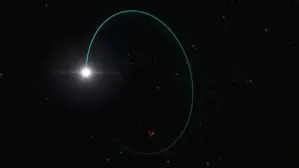
As scientists were studying data around the European Space Agency’s Gaia mission, they noticed a strange wobble in a particular star that was situated in the constellation of Aquila, according to Newsweek. It turned out that this wobbling motion in the star was due to the tension caused on it by the black hole by the name of Gaia BH3.
Biggest stellar black hole: One in a lifetime discovery, claim researchers
According to researchers and scientists, no one expected such a big mass would be lurking in such proximity to our planet and finding these kind of celestial objects happen very rarely. Based on Newsweek report, black hole Gaia BH3 is expectedly 33 times bigger than the sun, which is situated at the centre of our solar system, around which Earth revolves. Moreover, the celestial body is situated approximately 2,000 light years away from the Earth, making it the second-closest black hole around the solar system, say reports.
When do stellar black holes occur? How powerful are they?
Stellar black holes occur from the remains of gigantic stars which die and leave the star’s core wandering in the universe. These stellar black holes have such massive gravitational pull that powerful phenomenon like light cannot escape from its pull.
FAQs:
Q1. Which black hole has been recently discovered?
A1. A black hole by the name of Gaia BH3 has been recently discovered by researchers of the cosmic world while analyzing their readings on a ‘wobbling star’, at the European Space Agency. Q2. What are black holes made of?
A2. Black holes are made of huge amount of mass confined to a space and has an immense gravitational pull, so strong that light cannot escape from it. These occur, generally, after the death of giant stars.
Disclaimer Statement: This content is authored by a 3rd party. The views expressed here are that of the respective authors/ entities and do not represent the views of Economic Times (ET). ET does not guarantee, vouch for or endorse any of its contents nor is responsible for them in any manner whatsoever. Please take all steps necessary to ascertain that any information and content provided is correct, updated, and verified. ET hereby disclaims any and all warranties, express or implied, relating to the report and any content therein.



















































